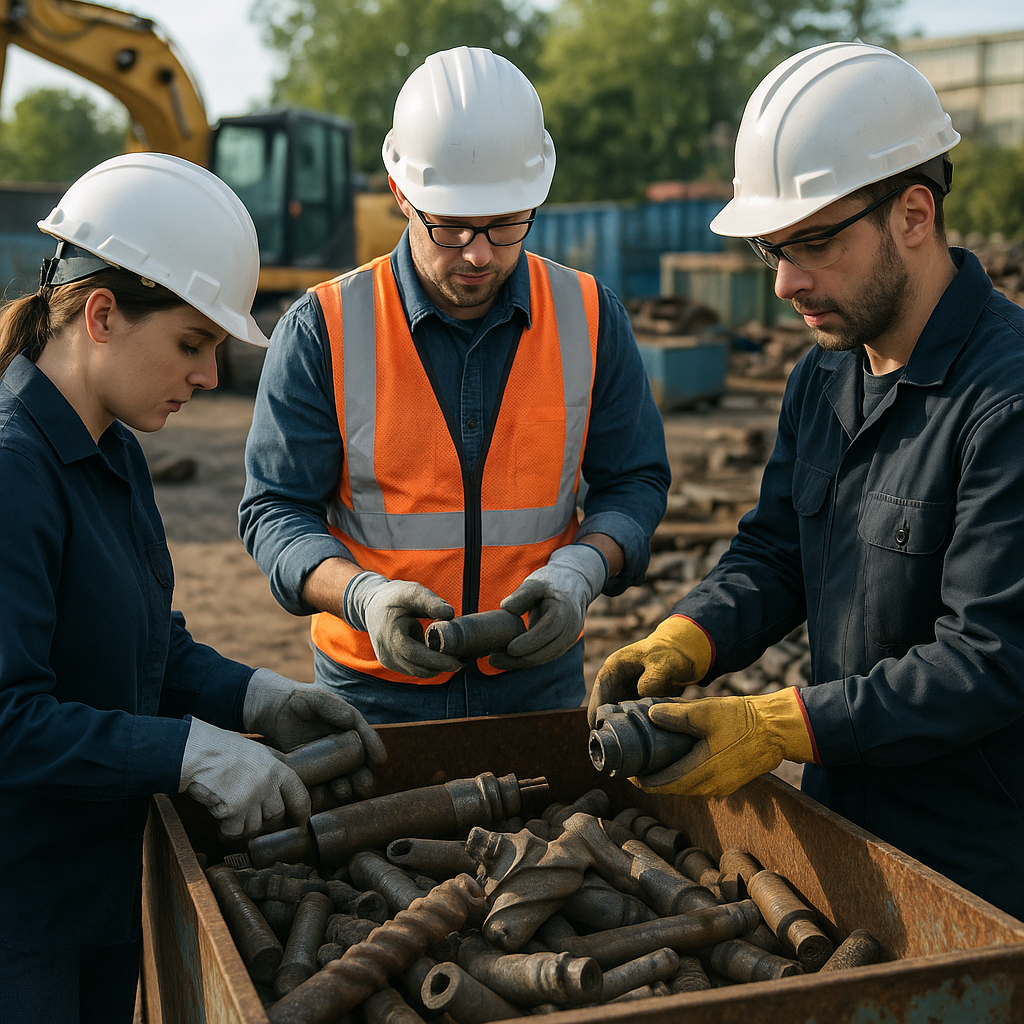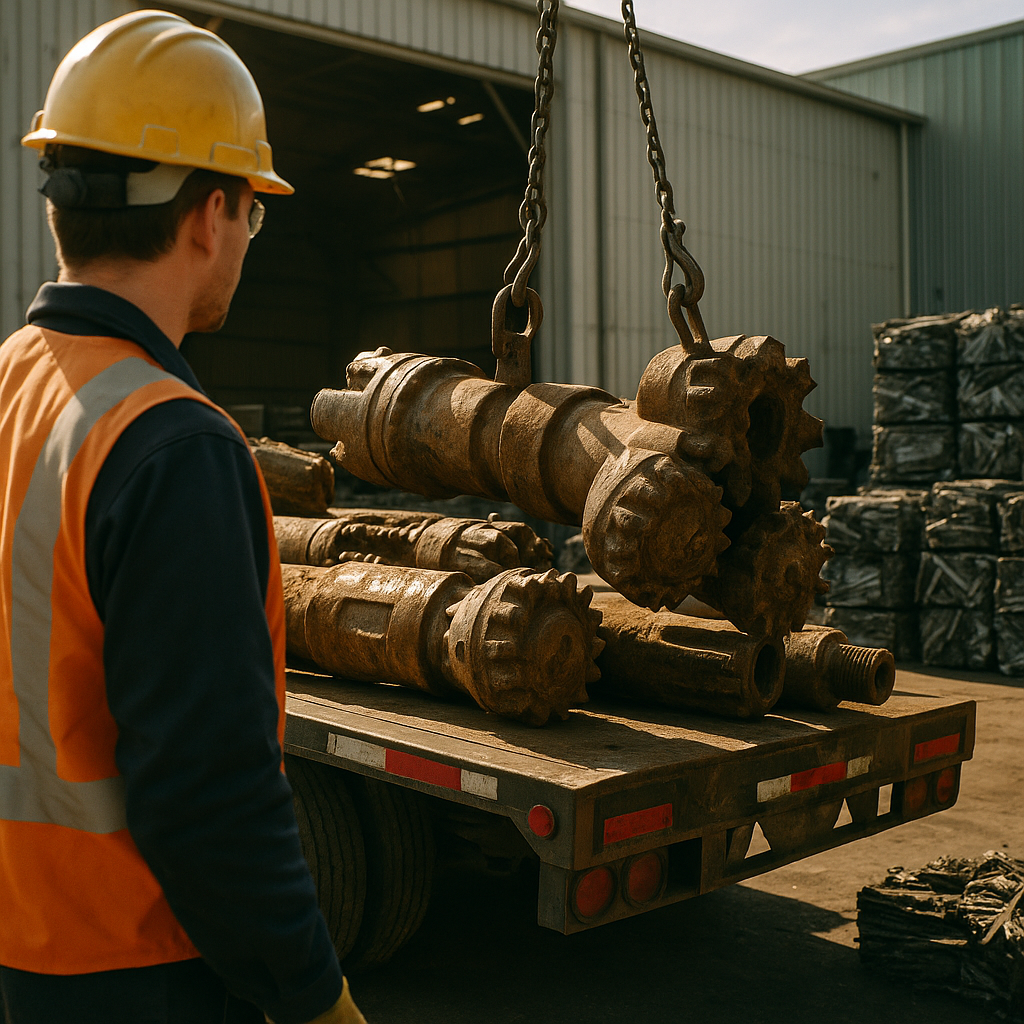5901 Botham Jean Blvd, Dallas, TX 75215
What Parts of a Drilling Rig Can Be Recycled?
August 7, 2025The oil and gas industry generates over 1.3 billion tons of waste annually, with drilling operations significantly contributing to this environmental challenge. Many drilling rig components can be recycled rather than discarded, offering substantial opportunities for waste reduction.
Drilling rigs include several recyclable components that can be repurposed at the end of their operational life. The crown block, drill collar, standpipe, rotary hose, fuel tanks, casing, drill pipe, and drill bits are all ideal for recycling programs that help minimize environmental impact.
The industry increasingly recognizes that sustainable drilling practices are not only beneficial for the environment but also make strong business sense. Recycling drilling rig components reduces waste management costs, decreases the need for virgin materials, and helps companies meet their sustainability targets in an era of heightened environmental awareness.
How Does Steel and Carbide Recycling Work in Drilling Operations?

Steel and carbide recycling in drilling operations involves recovering valuable materials from used drilling equipment. This process is crucial for sustainability in the oil and gas industry. It focuses on separating steel components from carbide inserts, which are commonly found in drilling bits and tools.
The Steel and Carbide Separation Process
The recycling process begins with waste generated from worn-out drill bits, damaged tools, and other components. These typically contain both steel and tungsten carbide, a super-hard material used in cutting surfaces. The separation involves several key steps:
- Collection and sorting of materials by composition
- Mechanical preprocessing to remove contaminants like mud and chemicals
- Physical separation of steel from carbide inserts using specialized equipment
- Chemical processing to separate materials at a molecular level
- Refinement of recovered materials to meet quality standards for reuse
The steel components, which make up most drilling tools, are processed through conventional steel recycling methods. Reclaimed steel can be melted down to create new drilling equipment or other steel products, reducing the need for virgin iron ore extraction and its environmental impacts.
Advanced Chemical Recovery Methods
The most complex part is the recovery of tungsten carbide. Unlike simple metals, carbide is a composite material of tungsten and carbon atoms. Recyclers use advanced chemical methods to break these materials down to the atomic level. The carbide recycling process typically includes:
- Chemical dissolution in acid baths to separate tungsten from other elements
- Filtration to remove impurities and isolate pure tungsten compounds
- Thermal treatment to convert tungsten compounds back to tungsten metal
- Carburization, where carbon is reintroduced to form new tungsten carbide
- Powder formation through ball milling to create fine tungsten carbide powder
The quality of recycled tungsten carbide is exceptional. When correctly processed, it produces powder that is virtually identical to virgin material in terms of performance and durability. This recycled powder is used to manufacture new drill bit inserts and other cutting tools.
Benefits of Steel and Carbide Recycling in Drilling
This recycling process offers significant benefits for both the industry and the environment. Tungsten is a rare and valuable metal with limited global reserves. Recycling conserves this resource while reducing the energy consumption associated with primary tungsten production.
Benefits include:
- Reduced mining impact and raw material extraction
- Energy savings of up to 70% compared to processing virgin materials
- Conservation of tungsten, a strategic metal with limited natural reserves
- Reduced drilling waste sent to landfills
- Lower overall carbon footprint for drilling operations
Drilling companies are increasingly implementing closed-loop recycling programs where used bits and tools are sent directly to specialized recyclers. These programs help companies achieve sustainability goals while potentially reducing costs through material recovery and waste management savings.
As recycling technology advances, material recovery efficiency improves. Modern facilities now recover over 95% of tungsten content from used carbide tools, making the process environmentally sound and economically viable for drilling operations worldwide.
What Are the Benefits of Recycling Drilling Rig Components?

Recycling drilling rig components offers substantial benefits across environmental, economic, and operational dimensions. By prioritizing the recovery and reuse of drilling equipment parts, companies create value and reduce their ecological footprint. These advantages extend beyond simple waste reduction.
Environmental Benefits
The environmental advantages of recycling drilling rig components are significant. By reclaiming materials from used equipment, companies greatly reduce the need for new raw material extraction, leading to lower carbon emissions throughout the supply chain.
Manufacturing new drilling components from virgin materials generates roughly 75% more greenhouse gas emissions than refurbishing existing components. Recycling a single large drilling rig can prevent emissions equivalent to removing 50 passenger vehicles from the road for a year.
Recycling also minimizes landfill waste. Drilling components often contain valuable metals and materials that take centuries to decompose and can leach harmful substances into soil and groundwater when improperly disposed of.
Resource Conservation and Supply Security
Many drilling rig components contain scarce or critical minerals facing supply challenges. Tungsten carbide, used in drill bits and other high-wear components, is particularly valuable and considered a strategic resource by many governments.
A closed-loop recycling system for these materials ensures a more stable supply chain, less vulnerable to market volatility and geopolitical tensions. This approach aligns with the principles of a circular economy, where resources remain in productive use rather than being discarded.
In the North Sea, one major operator implemented a comprehensive recycling strategy that recovers over 80% of valuable materials from decommissioned rigs, including not only common metals but also specialized alloys for high-pressure, high-temperature applications.
[[artifact_table]] Environmental and Economic Impact of Drilling Component Recycling [[/artifact_table]]Economic Advantages
The financial benefits of recycling drilling rig components are compelling. Companies can achieve substantial cost savings through reduced material purchases, lower waste disposal fees, and decreased regulatory compliance expenses.
Refurbishing and redeploying equipment often costs 40-60% less than purchasing new components. For larger components like derricks or mud pumps, these savings can amount to hundreds of thousands of dollars per item.
A drilling contractor in Texas implemented a landfill diversion program achieving a 70% recycling rate for rig components, reducing waste management costs by 35% while generating revenue from recovered materials. The company found that partnering with specialized recyclers who understand the value of drilling-specific materials was key to maximizing returns.
Operational Efficiency
Recycling programs often improve operational practices. By tracking components through their lifecycle, companies gain valuable data about performance, failure points, and maintenance needs.
This information helps optimize future designs and maintenance schedules. Companies with comprehensive recycling programs report fewer unplanned shutdowns and improved overall equipment effectiveness.
Modern refurbishment techniques can even enhance recycled components’ performance, applying advanced coatings or upgraded materials to extend service life and improve resistance to harsh conditions.
Regulatory Compliance and Corporate Responsibility
As environmental regulations tighten globally, proper management of drilling waste becomes increasingly important. A structured recycling program helps companies stay ahead of regulatory requirements while demonstrating commitment to environmental stewardship.
Many operators now include recycling metrics in their sustainability reporting, which is increasingly valued by investors, partners, and customers who prioritize responsible business practices.
The drilling industry has begun adopting more sustainable materials designed for eventual recycling. Biodegradable drilling fluids, recyclable composites, and modular equipment designs all facilitate end-of-life recovery and processing.
By embracing the circular economy model through comprehensive recycling programs, drilling companies position themselves for long-term success in an industry under increasing pressure to reduce environmental impact while maintaining operational excellence.
What Challenges Exist in Recycling Drilling Rig Parts?

The recycling of drilling rig parts involves unique technical challenges due to the materials and processes used. A major hurdle comes from the abrasive properties of drilling waste, with drilling fluids often containing particles that cause wear and tear on recycling machinery. This results in reduced equipment lifespan and increased maintenance costs.
Material separation is another significant obstacle. Drilling equipment comprises multiple types of materials—from metals and alloys to plastics and composites—that must be segregated before recycling. Long-chain synthetic polymers in drilling fluids especially complicate this, as they create a sheeting effect on shaker and mud cleaner screens, which reduces separation efficiency and increases waste volumes.
The volume of waste generated during drilling operations further complicates recycling efforts. As noted in industry research, the onshore drilling fluid market is projected to reach USD 6,660.67 million by 2031, underscoring the scale of materials needing processing. Efficiently managing these volumes requires substantial investments in infrastructure and logistics.
Economic factors also impact drilling waste recycling. While advanced technologies like thermal desorption, centrifugation, and bioremediation offer effective solutions, their high costs often present barriers, particularly for smaller operators. These economic challenges compel companies to weigh immediate costs against potential environmental benefits and regulatory penalties.
Regulatory compliance is another complexity. Environmental regulations governing the handling and disposal of drilling waste, which vary by region, generally require strict adherence. For instance, the U.S. Environmental Protection Agency’s Resource Conservation and Recovery Act (RCRA) mandates specific treatment and disposal protocols that recycling operations must follow, adding administrative and operational burdens.
Innovative Solutions Emerging in the Industry
Despite these challenges, the industry is developing innovative approaches to enhance drilling waste recycling. Closed-loop drilling fluid systems are promising solutions, using steel tanks instead of earthen reserve pits for containment, enhancing monitoring, reducing waste, and facilitating more efficient recycling.
Bioremediation techniques are gaining traction as cost-effective methods for treating particular drilling wastes. These processes use microorganisms to break down or neutralize harmful elements, offering environmental benefits at potentially lower implementation costs than mechanical alternatives.
Zero discharge systems are also advancing, aimed at eliminating pollutant release into the environment. These systems typically include multiple treatment stages to process waste for reuse or safe disposal, addressing both environmental concerns and regulatory requirements.
Customized recycling solutions tailored to specific project needs are increasingly common. Since not all treatment technologies apply universally to each type of drilling fluid, companies must adopt diversified approaches based on waste composition, volume, and local regulations. This customization, though challenging, allows for more efficient resource recovery and waste reduction.
The oil and gas industry’s growing commitment to environmental stewardship is driving ongoing innovation in drilling waste recycling. As companies balance operational needs with sustainability goals, developing more efficient, cost-effective recycling technologies remains a priority for addressing the complex challenges of drilling rig waste management.
Conclusion: The Future of Drilling Rig Recycling
The recycling of drilling rig components is a crucial step in the oil and gas industry’s pursuit of sustainability. As environmental regulations become more stringent and corporate sustainability commitments grow stronger, companies increasingly recognize that responsible management of equipment at the end of its life cycle provides both environmental and economic advantages. Emerging technologies in this field—ranging from advanced material separation techniques to bioremediation processes that neutralize harmful substances—are transforming materials once considered waste into valuable resources.
Adopting a circular economy in drilling operations not only minimizes waste and preserves resources but also fosters new business opportunities within the recycling sector. For specialized drilling rig recycling needs, contact Okon Recycling at 214-717-4083.
